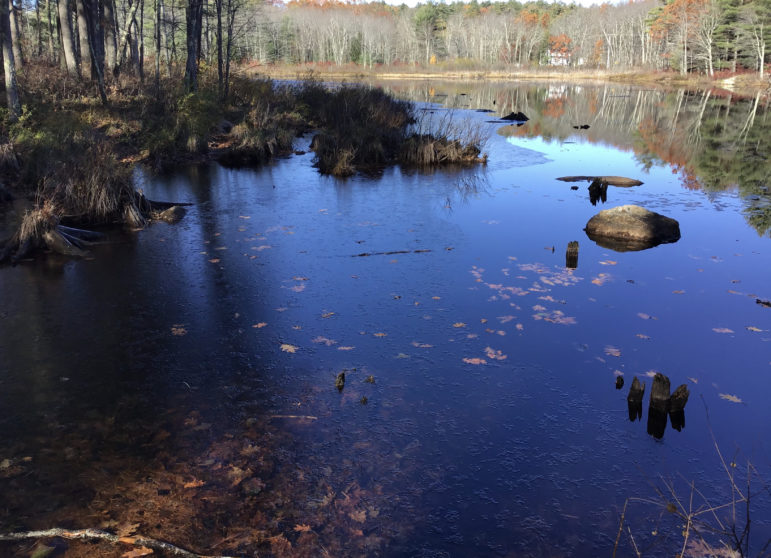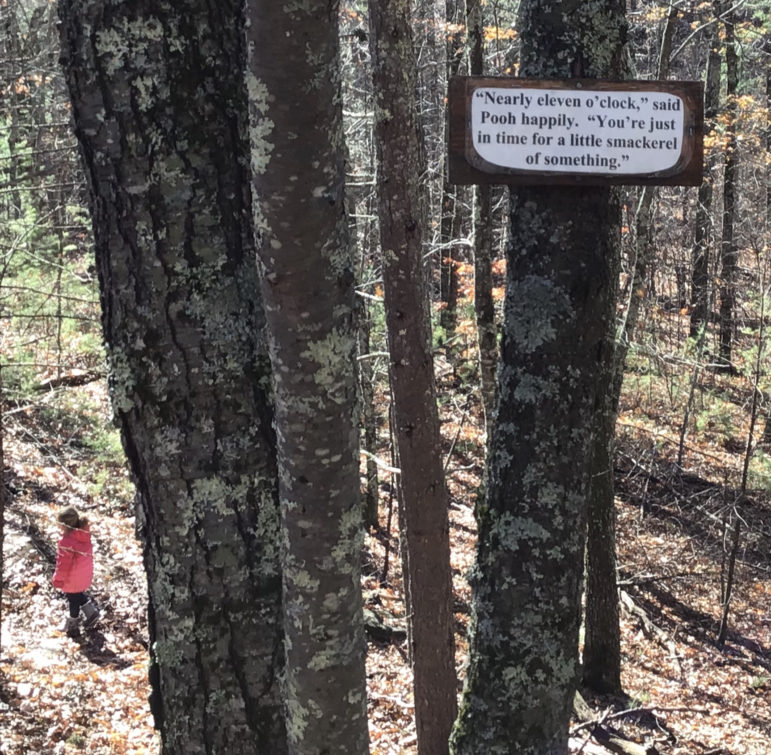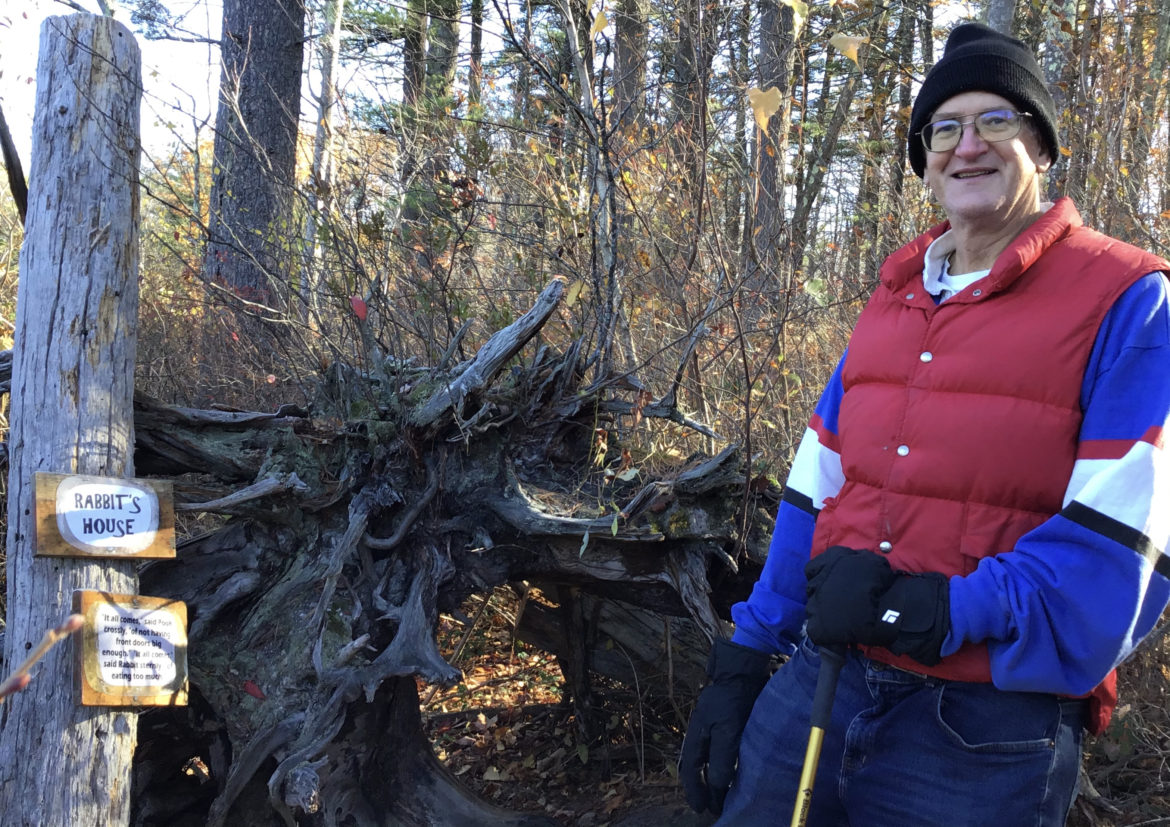By TERRY FARISH, InDepthNH.org
I found a little book at Calef’s Country Store in Barrington called Jim Schulz’s Walking Trails of Barrington, NH, Updated and Revised by John Wallace, 2020.
I wanted to meet this John Wallace. I didn’t know he’d been head of the Barrington Conservation Commission for 15 years and was until about a year ago. I didn’t live in the town. But I had walked the Pooh Trail just off Route 9 many times with my daughter.
Did John Wallace know anything about how the Pooh Trail came to be? I loved finding the Barrington Town Forest which is nearly impossible to find but when I did, I found it has an amphitheater created with terraced seating made of rows of stones and benches.

I found what I later would learn people call the Tamposi land. (Samuel A. Tamposi Water Supply Reserve) This is 1,513 preserved acres at the end of Tibbetts Road with trails running across named, for example, Rudolph’s Run and Santa Claus Trail.
There’s a hill called Mt. Ripley (“elevation 341 feet” warns The Walking Trails of Barrington). Ripley is a golden retriever. You can see him pictured in the book sitting on a rock. “Ripley (2005-2019) atop his eponymous summit.” In all, the guidebook walks the reader along 16 trails.
Who was behind the whimsy and joyfulness in the way Barrington offers its protected forests and open spaces to all of us to fall in love with?
Then I met John Wallace.
We met first by zoom because it was raining and couldn’t walk the trails. John was seemingly understated, modest. Later I think he is wry. What is the conservation commission? He said conservation commissions have a common goal with the statewide Society for the Protection of New Hampshire Forests (Forest Society) and regional land trusts, “to preserve the natural heritage of New Hampshire.”
Barrington has 18% – 19% conserved land. About average, John thinks. They have a Trails Committee led by Charles Tatham, an entomologist, who plan and maintain those trails you and I walk. Tatham and the committee also helped to update The Walking Trails of Barrington.
The New Hampshire Association of Conservation Commissions reports that New Hampshire has 216 conservation commissions including Barrington’s, each made up of volunteers working to preserve the natural resources of their community.
When I asked what John feared, concerning the wellbeing of the land, he spoke broadly about climate change. Research led by The Nature Conservancy, a global conservation organization, shows that forest conservation and planting new trees are a major contributor to the reduction of greenhouse gas emissions. “Natural climate solutions are conservation, restoration and improved land management actions that increase carbon storage or avoid greenhouse gas emissions in landscapes and wetlands across the globe,” a Nature Conservancy study reports.
John grew up outside New York City. But as a boy in the summers he went to Pine Island Camp on an island in Great Pond in the Belgrade Lakes region of Maine. It first opened in 1902. John’s father went for summers to the camp, then John, and his brother, and then John’s son. Cliché, he says, but those summers in what was almost the wilderness shaped him.
When he moved to Barrington in 1996, he says “it was inherent in me” to be drawn to the town’s forests and trails. I told him his story of father and son at the camp reminded me of E. B. White’s essay, “Once More to the Lake.” He said he admired everything by E.B. White and I wonder if he might be an English major. But no, biochemistry.

Barrington conservation began with Jim and Ann Schultz. John said, “They were like the grandparents of the conservation movement in the late 1980s and early 90s.”
I talked to Marie Harris of Barrington, former New Hampshire Poet Laureate, who was Jim’s and Ann’s neighbor before Ann died and Jim moved to Riverwoods. They lived near the Isinglass River. Marie said, “Jim and Ann were the heart and soul of the Barrington conservation movement.”
They began mapping public walking trails on their own land. In 1991 they donated part of their land to the town and it was protected in a conservation easement. John wrote that their work resulted in the protection of 4,000 acres in town.
Jim first published Walking Trails in 2006. In 2020, when the original guide was no longer available, John decided to do an update and republish it. He added maps to Jim Schultz’s book. “I love maps.” He added graphics and photos. He added illustrations of Christopher Robin and Pooh by Ernest H. Shepard from A. A. Milne’s Winnie The Pooh.
John came to Barrington to work at the University of New Hampshire conducting research in biochemistry. I didn’t think in his line of work that he’d be connected to Pooh. I almost didn’t ask about the signs on the Pooh Trail, marking the forest houses of Christopher Robin’s friends.
“Oh, Bear!” said Christopher Robin,
“How do I love you!”
“So do I,” said Pooh.
And at Eeyore’s house
“Rather sad and gloomy.”
But I do ask. “I did it,” he said. He’d seen such a trail in the Poconos when he was a kid and he wanted to bring it to Barrington. “It’s hardly just a kid’s story,” he said. “I grew up with it and I read it to my kids.”
Well. So we plan to meet there when the sun comes out.

On Halloween morning John and I met up at the Pooh Trail. Kids and parents were spilling out of cars and into the woods in bright colored coats. The pond had a cover of ice. John is extremely tall – 6’5″.
He had a walking pole to better climb the rocky hills. The trail leads off with ‘Sing Ho! for the Life of a Bear.’ And progresses to the houses of Owl, Piglet, Rabbit, and more. We climbed, and he noted details of the trail he’d designed, a downed sign showing the way to Pooh’s House, a walking log bordering the trail that he was pleased to see a tiny girl maneuvering.
Eeyore’s stick house needed some rebuilding. Pooh’s house is in a magnificent ledge which John stocks with jars labeled honey.
The Pooh Trail is part of the Goodwill Conservation Area that doubled in size in 2020. It’s the trees, John said, that interest him the most. In the guidebook he pauses the reader at one point on the Goodwill trail.
“You’ll encounter a large big-tooth aspen tree, with beautiful deeply grooved bark.” It was once the largest aspen known in Strafford County.
A bigger one has been found, he writes. But “the NH Big Tree program, which keeps records, has the philosophy of ‘once a champ, always a champ.'”
The town’s preserved land is under forest management, meaning techniques are used to improve habitat for wildlife and water quality. Sometimes trees are harvested. Hunting and fishing are allowed. “NH Fish and Game are part of the conservation process.” The Trails Committee keeps an eye out for overuse and sometimes closes the trails to allow them to recover.
But today with many children on the Pooh Trail, John says he wants to do some scavenger hunts and more kids’ activities on other town conservation lands. How’s it feel to see all these little kids in the woods? “It’s lovely,” he said. “Just lovely.”
Terry Farish is a freelance writer and novelist living on the Seacoast who writes for InDepthNH.org. She has written widely about contemporary immigration. Please contact her with ideas for immigrant and refugee stories, under-told stories, and stories that may not yet be part of the narrative of New Hampshire. She is especially interested in teen stories. tfarish@gmail.com





